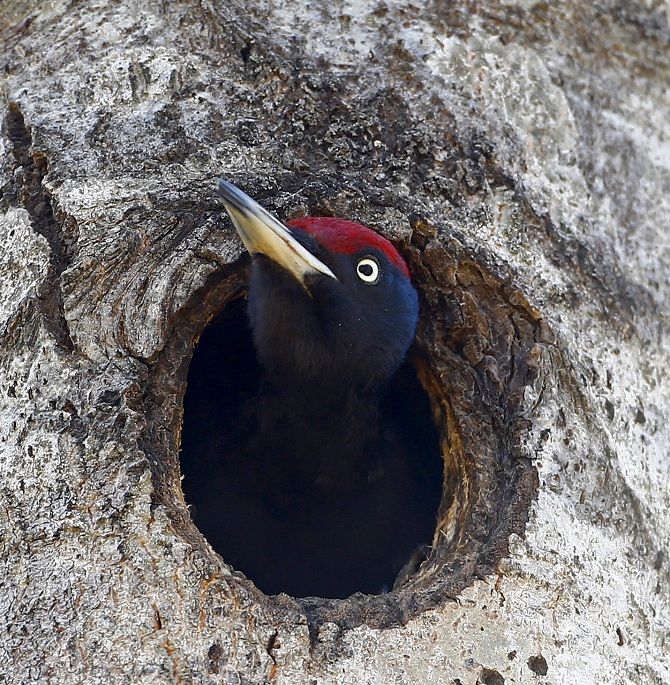The advent of summer is heralded by the advent of thousands of Rosy Starlings -- noisy, friendly birds that transform early summer mornings into a brassy concerto.
The advent of summer is also when the peafowl are at their busiest.
The idea that home itself could have hitherto undiscovered delights, was a lovely one for Geetanjali Krishna.

I always associate the coming of spring with the first blush of scarlet on the silk cotton trees in Delhi. After the glorious blooms burst into tufts of cotton and the trees are left bereft of flower and leaf, the advent of summer is heralded by the advent of thousands of Rosy Starlings.
These noisy, friendly birds sit on the bare branches of the silk cotton tree, transforming early summer mornings into a brassy concerto.
The advent of summer is also when the peafowl are at their busiest. Peacocks dance for their harems of peahens, and the females mate only when they believe the male has outdone himself.
While the peacock's dance is lovely, albeit a little desperate, it is a delight to watch the behaviour of these large birds. That is why when last weekend, a birder friend invited us to observe Rosy Starlings and other birds in his backyard, with the promise that the peacock that danced every morning in his garden would entertain us with a floor show over breakfast, we accepted with alacrity.
So off we went early last Saturday morning to the Railway Eco Park in Chanakyapuri for an expedition to discover the birds in our backyard.
Having recently spent more time travelling than at home, the idea that home itself could have hitherto undiscovered delights to discover, was a nice one. Too many road trips on bumpy Indian roads will do that to you.
For a park of its size, the EcoPark was full of life, situated next to a low-set railway line and surrounded by classic Aravali scrub undergrowth.
The best thing is that it was relatively unfrequented, unlike the much larger Hauz Khas District Park and Lodhi Gardens.
Our host, Devendra Singh, a keen naturalist and birder, spotted the first Sambar deer in a nearby Delhi park last year. Thanks to his observations, a small but hitherto undiscovered population of these deer has been found in Delhi and its environs.
"At this time, this park has over 42 species of birds," he said.
The Rosy Starlings were chirping noisily as we crossed the metal bridge over the railway line to enter the park. I looked up and saw hundreds of them on a single ficus tree.
Some call them Rosy Pastors, on account of their somewhat disapproving way of looking down at you in their black coats.
To me, they're more like an avian cabaret troupe that performs incredible aerobatic feats. These birds are serious flyers -- they winter in India and tropical Asia, and come summer, head to Eastern Europe, flying in formations that have long puzzled scientists.
Why the starlings fly in such tight, perfect murmurations is one of nature's unsolved mysteries, and I marvelled at being able to observe it so close to home.
A mongoose stepped out from behind a rock ahead on the path. Two more followed. We watched their antics, musing how this once-ubiquitous carnivore is now such a rare sight in the city.
Green Bee Eaters flitted about on the trees. Although still quite common in Delhi's wooded areas, they too are being edged out of their urban habitats by pigeons and crows.
Oriental White Eyes, pretty green birds with very distinctive eye markings, were on a nearby branch.
Then we reached the base of a tree, with a hollow that had a slit-like aperture.
"This year, a pair of Grey Hornbills fought with a Myna for this nesting spot," said Singh. "The female has barricaded herself inside to hatch her eggs, safe from the Myna's depredations."
As we watched, the male hornbill swooped overhead, bringing back juicy tidbits for his beloved. "He'll provide for her until the chicks are ready to emerge from the nest," Singh explained.
Just then, his phone rang. "The peacock has begun its dance," said he. "It's time for breakfast!"
But by the time we reached his backyard, the dance was over, and we couldn't tell whether the desperately dancing peacock had had any success with his women.
So instead, over delicious hot idlis and masala chai, we looked at our photographs and marvelled at how much we'd been able to discover from a simple ramble in the park.
Please scroll down for exclusive stories of conservation in India











